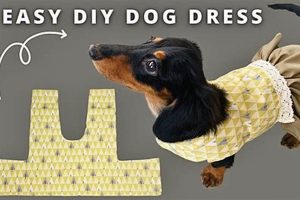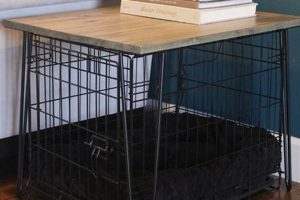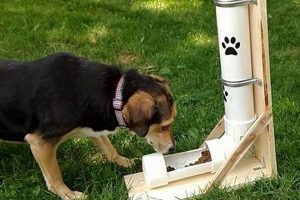The concept involves constructing canine sleeping quarters from timber through a do-it-yourself approach. Such projects can range from simple frames to more elaborate designs incorporating cushioning and aesthetic detailing. An example would be building a raised platform bed from repurposed pallets, sized appropriately for the dog and finished with a non-toxic sealant.
Undertaking such an endeavor offers several advantages. Cost savings compared to purchasing manufactured alternatives is often a primary motivator. Furthermore, it allows for customization to match specific canine needs, breed size, and home decor. Historically, constructing pet furniture from available materials was a common practice, reflecting resourcefulness and a desire to provide comfort for animal companions.
The subsequent sections will explore various design considerations, material selection guidelines, and step-by-step construction methods relevant to creating personalized and functional resting places for dogs.
Tips for Constructing Canine Timber Sleep Spaces
Considerations during the planning and construction phases of a timber canine bed project are critical for ensuring both its structural integrity and the animal’s safety and comfort. The following points offer essential guidance.
Tip 1: Material Selection is Paramount: Employ only untreated lumber to mitigate the risk of chemical exposure. Opt for hardwoods like maple or oak for increased durability, particularly for larger breeds.
Tip 2: Prioritize Joint Stability: Use robust joinery techniques, such as mortise and tenon or pocket-hole screws with wood glue, to ensure the frame can withstand the dog’s weight and movement.
Tip 3: Sand All Surfaces Thoroughly: Eliminate splinters and rough edges by meticulously sanding all wooden components. Pay particular attention to corners and areas where the dog will have direct contact.
Tip 4: Consider Elevated Designs: Raising the bed off the floor can improve air circulation and provide insulation, especially in colder climates. Ensure the elevation is appropriate for the dog’s age and mobility.
Tip 5: Implement a Removable Bedding Platform: Construct a platform that can be easily removed for cleaning or replacement of bedding materials. This promotes hygiene and simplifies maintenance.
Tip 6: Apply a Non-Toxic Sealant: Protect the wood from moisture and wear by applying several coats of a pet-safe, non-toxic sealant. Allow ample drying time between coats and before introducing the bed to the dog.
Tip 7: Reinforce Stress Points: Identify areas likely to experience significant stress, such as corners and leg attachments. Reinforce these areas with metal brackets or additional wooden supports.
Adhering to these guidelines will contribute significantly to creating a safe, durable, and comfortable resting place for the canine companion.
The subsequent section will address design variations and advanced construction techniques for further customization.
1. Wood Selection
The choice of timber significantly influences the durability, safety, and overall suitability of a do-it-yourself canine sleeping structure. The material’s properties dictate the bed’s longevity and impact the animal’s health and comfort.
- Hardwood vs. Softwood
Hardwoods, such as oak and maple, offer greater resistance to wear and tear, making them suitable for larger or more active dogs. Softwoods, like pine, are more economical but may be prone to scratches and damage. The selection depends on the dog’s size, activity level, and the desired lifespan of the structure.
- Untreated vs. Treated Lumber
Untreated lumber is essential for pet safety. Pressure-treated wood contains chemicals that can be harmful if ingested or through prolonged contact. The use of untreated timber minimizes the risk of poisoning or allergic reactions.
- Wood Density and Stability
Denser woods provide greater structural stability, ensuring the bed can withstand the dog’s weight and movements. Stable woods resist warping and cracking, maintaining the bed’s integrity over time. Choosing appropriate density and stability prevents premature failure and ensures lasting use.
- Sourcing and Sustainability
Selecting wood from sustainable sources demonstrates environmental responsibility. Options include reclaimed wood, which reduces waste, or timber certified by organizations promoting responsible forestry practices. Sustainable sourcing supports ecological balance and reduces environmental impact.
These facets collectively highlight the importance of informed wood selection in creating safe, durable, and environmentally conscious canine sleeping quarters. The correct choice ensures a longer lifespan for the construction and contributes positively to the animal’s well-being.
2. Structural Integrity
The stability and load-bearing capacity are paramount when constructing canine sleeping structures from timber. The term refers to the capacity of the construction to withstand the forces exerted by the animal, ensuring longevity and preventing collapse. Compromised integrity can result in injury to the animal and premature failure of the structure.
- Joint Strength
The method by which wooden components are joined significantly affects overall stability. Dovetail, mortise-and-tenon, or adequately secured screwed joints are preferable to simple nailing, especially for larger breeds. Inadequate joint strength leads to instability and potential separation under stress.
- Material Thickness and Span
The dimensions of the lumber must be appropriate for the span between supports. Thinner materials spanning long distances are prone to sagging or breakage under load. Selection of lumber thickness should consider the animal’s weight and the anticipated stress distribution.
- Support Placement
The positioning and quantity of supports are crucial for distributing weight evenly across the frame. Insufficient support leads to concentrated stress points, increasing the likelihood of failure. Strategic placement of supports ensures balanced load distribution.
- Fastener Selection and Placement
The choice of fasteners, such as screws or bolts, and their spacing impacts the resistance to shear and tensile forces. Improper fasteners or inadequate spacing compromise the connection strength, reducing the overall stability of the structure. Appropriate fastener selection and strategic placement are critical for joint integrity.
These elements, considered collectively, dictate the resilience and lifespan of the timber-based canine bed. Attention to these structural facets is essential to deliver a safe and durable resting space for the animal.
3. Safety Finishes
The application of appropriate surface treatments is integral to the safe utilization of a do-it-yourself timber canine bed. The materials employed to seal, stain, or paint the wood directly impact the potential for harm to the animal. Ingestion, inhalation, or dermal contact with inappropriate finishes can lead to toxicological consequences. A primary cause of concern is the presence of volatile organic compounds (VOCs) in conventional paints and varnishes, which can off-gas and pose respiratory irritants or more severe health risks. For example, using oil-based paints can expose the dog to harmful fumes for an extended period, whereas water-based finishes with low or zero VOC content provide a safer alternative.
The selection criteria for finishes must prioritize non-toxicity and durability. Specifically, products certified as pet-safe or compliant with standards for children’s toys offer a suitable level of assurance. Natural oils, such as linseed or tung oil, can provide a protective barrier but require thorough drying to prevent residue ingestion. An instance would be applying multiple thin coats of beeswax polish, allowing each coat to fully cure, to create a natural and non-toxic sealant. The omission of proper safety measures regarding finishes transforms the bed from a comfortable space into a potential hazard.
In conclusion, safety finishes represent a non-negotiable component of constructing a timber-based canine bed. Adherence to established safety standards and the conscientious selection of non-toxic materials are vital. While the desire for aesthetic appeal is understandable, it should never supersede the primary objective of ensuring the animal’s well-being. The challenge lies in balancing durability, aesthetics, and safety, demanding careful research and responsible application.
4. Size Appropriateness
The dimensional conformity of a self-constructed timber canine bed dictates its functionality and influences the animal’s comfort and health. Inadequate sizing compromises usability, while excessive dimensions may negate the bed’s intended purpose within a confined space. Therefore, accurate assessment and implementation are crucial.
- Internal Dimensions Relative to Canine Size
The interior of the bed must accommodate the dog’s full body length in a relaxed, prone position, with additional space for stretching or repositioning. Constricting dimensions induce discomfort and impede natural sleep patterns. For instance, a Great Dane requires significantly larger internal dimensions than a Chihuahua to ensure adequate space and postural freedom.
- Height of Bed Walls or Sides
The vertical dimension of the bed’s perimeter should provide a sense of security without hindering the dog’s entry or exit. Excessive wall height may present a barrier for smaller or geriatric dogs. Conversely, insufficient height fails to contain bedding or provide a sense of enclosure. A balance is necessary to accommodate both physical accessibility and psychological comfort.
- Weight Capacity Considerations
While dimensionally appropriate, the structural components must withstand the animal’s weight without deformation or failure. Lumber thickness and support placement must correlate with the dog’s mass to ensure structural integrity. A bed constructed from lightweight materials, despite suitable dimensions, may collapse under the weight of a larger breed, rendering it unusable and potentially hazardous.
- Accessibility for Aging or Ailing Animals
Modifications to the design may be necessary to accommodate canines with mobility limitations. Lower entry points or the incorporation of ramps can facilitate access for geriatric or arthritic animals. Neglecting accessibility features compromises the bed’s utility and potentially exacerbates existing physical challenges.
These considerations illustrate the necessity of precise dimensional planning in the construction of a timber canine bed. Accurate sizing contributes directly to the animal’s well-being, ensuring a comfortable, safe, and functional resting space. Failure to address these points diminishes the value and practicality of the self-constructed item.
5. Design Aesthetics
The visual attributes of a self-constructed canine timber bed represent more than mere superficial embellishment; these elements influence integration with domestic surroundings and, consequently, user satisfaction. The choice of style, finish, and detailing directly impacts the bed’s perceived value and its harmony with existing interior decor. A poorly considered aesthetic can detract from the overall ambiance of a room, even if the bed is structurally sound and functionally adequate. For example, a rustic design incorporating reclaimed wood might complement a farmhouse-style interior, whereas a sleek, minimalist structure with clean lines and a dark stain would better suit a contemporary setting. The selection of an appropriate design aesthetic is therefore a key determinant of the bed’s successful incorporation into the home.
The application of specific design principles further enhances the aesthetic appeal. Consideration of color palettes, proportions, and material textures can elevate the bed from a purely utilitarian object to a visually pleasing element within the room. A bed incorporating elements of mid-century modern design, with tapered legs and a subtly curved frame, exemplifies the application of aesthetic principles to canine furniture. Furthermore, customization options afforded by the do-it-yourself approach allow for personalized touches that reflect the owner’s taste and complement the animal’s personality. This capability is particularly valuable when aligning the bed’s design with the owner’s established aesthetic preferences.
In summary, the aesthetic component of a timber canine bed is not an ancillary consideration, but an integral aspect that dictates its seamless integration into domestic life. The conscious application of design principles, informed by the surrounding environment and the owner’s preferences, transforms the structure from a functional item into a contributing element of the home’s overall visual narrative. The challenges lie in balancing personal taste with the need for durability and canine comfort, requiring thoughtful planning and execution to achieve optimal results.
6. Comfort Level
Canine comfort is a paramount determinant in the successful integration and utilization of a self-assembled timber dog bed. The animal’s willingness to rest within the structure is directly contingent upon the perceived comfort offered by the design and materials employed. The subsequent discussion will address key facets influencing the animal’s sense of ease within such a bed.
- Mattress or Cushioning Material
The selection of the inner bedding significantly impacts the dog’s comfort. Memory foam conforms to the animal’s body, providing support and pressure relief, which is particularly beneficial for older dogs or those with joint issues. Fiberfill, while more economical, may compress over time, reducing its supportive properties. The chosen material should provide adequate cushioning and insulation from the floor, minimizing pressure points and maintaining a comfortable temperature. For example, a thick orthopedic foam mattress can significantly improve the rest quality for a dog with arthritis compared to a thin, less supportive filling.
- Fabric Selection and Texture
The tactile properties of the fabric covering the bed’s surface influence the animal’s willingness to lie down. Soft, breathable materials like fleece or cotton provide a comfortable resting surface. Durable fabrics such as canvas or denim can withstand wear and tear, but may lack the initial softness of other options. The fabric should also be easy to clean and resistant to odors. A rough or scratchy fabric can deter the dog from using the bed, while a smooth, inviting texture encourages relaxation.
- Bed Dimensions and Enclosure
The overall size and configuration of the bed contribute to the animal’s sense of security and comfort. A bed that is too small restricts movement and prevents the dog from fully stretching out. A bed with raised sides or a partial enclosure can provide a sense of security and protection, particularly for dogs prone to anxiety. However, a fully enclosed bed may be too restrictive for some dogs. The dimensions should be proportional to the dog’s size and breed, allowing for comfortable rest and movement.
- Thermal Regulation Properties
The materials used in the bed’s construction influence its ability to regulate temperature. Certain fabrics, such as fleece, retain heat, making them suitable for colder climates. Breathable materials, like cotton, promote air circulation and prevent overheating in warmer environments. The bed’s design can also contribute to thermal regulation; an elevated bed allows for greater air circulation underneath, while a bed placed near a drafty window may be too cold. Consideration of the dog’s breed and the prevailing climate is essential for creating a comfortable and thermally balanced resting space.
The integration of these comfort-related facets into the design and construction of a timber dog bed is essential for ensuring its usability and acceptance by the animal. Careful consideration of mattress material, fabric texture, dimensions, and thermal properties directly translates into a resting space that the canine companion will willingly utilize, enhancing its overall well-being. The successful implementation of these elements transforms the bed from a mere wooden structure into a comfortable and inviting sanctuary for the dog.
7. Ease of Cleaning
Maintaining hygiene in canine sleeping areas is crucial for preventing the accumulation of allergens, parasites, and unpleasant odors. With do-it-yourself timber dog beds, design choices directly impact the ease with which these spaces can be cleaned and maintained. The subsequent points detail factors influencing cleanability.
- Removable Bedding Platforms
A primary consideration is the incorporation of a removable platform designed to hold bedding. This allows for the separate cleaning of both the bedding itself and the underlying wooden structure. A fixed platform, in contrast, necessitates more laborious cleaning procedures, potentially trapping debris and moisture. The use of a removable platform promotes more thorough and efficient sanitation.
- Material Selections and Finishes
The choice of timber and applied finishes significantly influences cleanability. Smooth, non-porous materials, such as sealed hardwoods, resist the absorption of liquids and odors more effectively than unfinished softwoods. The application of a durable, water-resistant sealant facilitates the removal of stains and spills, reducing the likelihood of bacterial growth. The selection of appropriate materials and finishes streamlines cleaning protocols.
- Joint Construction and Accessibility
The method of construction affects the accessibility of crevices and joints where debris can accumulate. Simple, open joint designs are easier to clean than complex configurations with concealed corners. Furthermore, elevated designs with adequate clearance beneath the bed facilitate vacuuming or sweeping, preventing the accumulation of dust and allergens. Design considerations must address accessibility for effective cleaning.
- Fabric Choices for Bedding
The materials used for bedding, such as cushion covers and blankets, directly impact ease of cleaning. Durable, machine-washable fabrics are preferable to delicate materials requiring specialized cleaning procedures. The ability to regularly launder bedding materials is essential for maintaining a hygienic sleeping environment. Selection of appropriate bedding fabrics is paramount for simplified maintenance.
These elements collectively illustrate the integral relationship between design decisions and maintainability within the context of self-constructed timber dog beds. Prioritizing cleanability through thoughtful design and material selection enhances hygiene and prolongs the lifespan of the structure.
Frequently Asked Questions
This section addresses common inquiries pertaining to the fabrication of canine sleeping accommodations from timber, providing clarity on design, materials, and safety considerations.
Question 1: Is it permissible to utilize treated lumber in the construction of a canine bed?
No. Treated lumber contains chemical preservatives, some of which pose a potential health risk to animals through ingestion or dermal contact. Untreated lumber is the recommended alternative.
Question 2: What joinery methods are best suited for ensuring structural integrity?
Mortise-and-tenon, dovetail, or pocket-hole screw joints, augmented with appropriate adhesives, offer superior strength and durability compared to simpler methods such as nailing or stapling. Joint strength is critical for supporting the animal’s weight.
Question 3: What types of finishes are appropriate for application to the completed structure?
Only non-toxic, pet-safe sealants or paints should be used. Products labeled as low-VOC (volatile organic compounds) are preferable to minimize potential respiratory irritation. Thorough drying is essential prior to introducing the animal to the bed.
Question 4: How does one determine the appropriate dimensions for a canine bed?
The interior dimensions should comfortably accommodate the dog’s full body length in a prone position, with sufficient additional space for stretching or turning. Height considerations should allow easy access for the animal while providing a sense of security.
Question 5: What bedding materials are recommended to optimize canine comfort?
Memory foam or orthopedic foam mattresses offer superior support and pressure relief, particularly for older or arthritic animals. Durable, washable fabrics such as fleece or cotton are appropriate for covering the bedding.
Question 6: How can the structure be designed to facilitate ease of cleaning?
Incorporating a removable bedding platform allows for separate cleaning of the bedding and the wooden frame. Smooth, sealed surfaces resist the absorption of liquids and odors, simplifying cleaning procedures.
These responses should provide a foundational understanding of common concerns in the construction of timber canine beds. The implementation of these guidelines contributes to both the safety and functionality of the finished product.
The subsequent section offers detailed instructions on the construction process.
Conclusion
The preceding exploration of the diy dog bed wooden concept has underscored the importance of material selection, structural integrity, safety finishes, appropriate sizing, design aesthetics, canine comfort, and ease of cleaning. Each facet contributes significantly to the creation of a safe, functional, and aesthetically pleasing resting space for canine companions.
Successful implementation of these principles requires diligent planning and execution. The final product should not only serve its intended purpose but also reflect a commitment to the animal’s well-being and the responsible use of materials. By prioritizing safety and durability, a handmade timber canine bed can provide years of reliable service and contribute positively to the pet’s quality of life.





![Build a Safe Sliding Dog Gate DIY [Easy Steps!] The DIY Hub: Creative Crafts, Repairs & Life Hacks Build a Safe Sliding Dog Gate DIY [Easy Steps!] | The DIY Hub: Creative Crafts, Repairs & Life Hacks](https://craftingdiycenter.com/wp-content/uploads/2025/07/th-2861-300x200.jpg)

